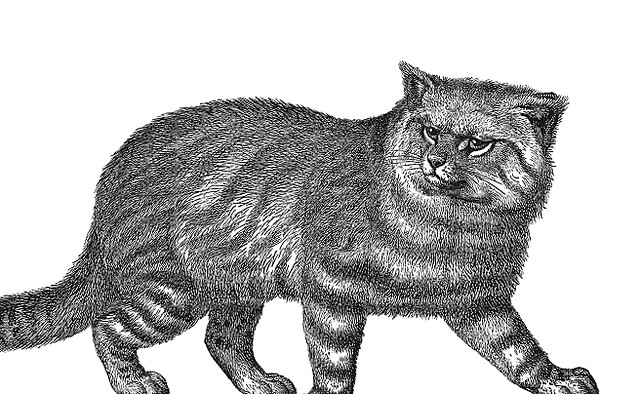The colocolo (Leopardus colocolo) is a small spotted and striped cat native to the west Andean slope in central and northern Chile.[2] Until recently, it included the more widespread Pampas cat (L. pajeros) and Pantanal cat (L. braccatus),[1]and some maintain these as subspecies of the colocolo.[3][4] Confusingly, when these are treated as subspecies of the colocolo, the “combined” species is sometimes referred to as the Pampas cat.[5]
The colocolo is a small, but heavy-set cat, only 56 to 67 cm (22 to 26 in) in body length, with a short 29 to 32 cm (11 to 13 in) tail, and weighing around 3 kg (6.6 lb) on average.[10] The two subspecies differ in their pelage colour and pattern:
- L. c. colocolo (nominate): Reddish or dark grey with rusty-cinnamon stripes on the flanks and two stripes on each cheek, a cinnamon upper side of the ears with black edges and tips, four or five reddish rings on the tail (outer two are darker), dark brown stripes on the legs, black chest spots, and whitish underparts with rusty-ochraceous stripes.[2] It is found in central Chile in subtropical, xerophytic forests at altitudes of up to 1,800 m (5,900 ft).[2]
- L. c. wolffsohni: Similar to nominate, but the flanks have large, reddish brown rosette-shaped spots with darker borders, the upper side of the ears are black with a greyish base and a small grey spot, usually eight rings are on the tail (of the same colour as the flank spots), and the stripes on the legs and spots/stripes on the underparts are very dark brown (almost black).[2] It is found in northern Chile in spiny shrublands and páramo.[2] Of two specimens, one was taken at an altitude between 2,000 and 4,000 m (6,600 and 13,100 ft), and the other at 4,100 m (13,500 ft).[2]
Externally, the colocolo differs from the Pantanal cat in its larger size, and pelage colour and pattern.[2] Some Pampas cats are as large as the colocolo, and some subspecies of the Pampas cats have the same pelage colour and pattern as colocolos of the subspecies L. c. wolffsohni.[2]
Little is known about the colocolo’s hunting and breeding habits; however, it is believed to prey mainly on small mammals and birds. Guinea pigs are thought to form a large part of its diet, along with viscachas and other rodents, and tinamous.[10] Though some have suggested it is chiefly nocturnal,[10] others suggest it is mainlydiurnal.[9]
Litters are relatively small, usually consisting of only one or two kittens, and occasionally three. The kittens weigh around 130 g (4.6 oz) at birth.[10] The average lifespan is nine years, but some have lived for over 16 years.[11]
(From Wikipedia, February 2015)




